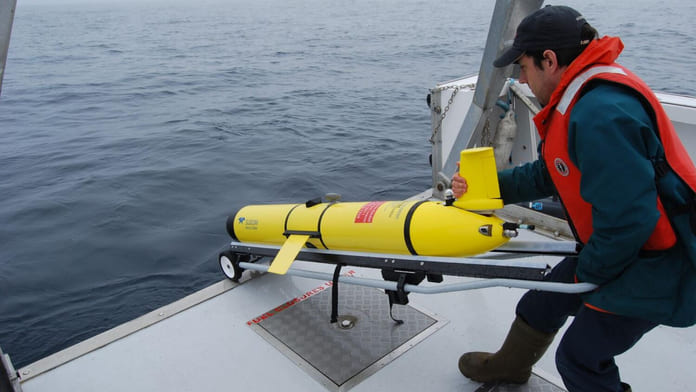SeaMonitor team successfully deploys robotic glider to track wild salmon at sea.
The persistent low marine survival rate of Atlantic salmon in the early stages of their migration to feeding grounds in the North Atlantic has long puzzled scientists and researchers.
Until now, most tracking studies had been limited to estuarine or coastal areas due to technological limitations and the need for stationary receivers.
This month, however, in a major development, the ability to track free swimming salmon juveniles has been extended hundreds of miles into the open ocean using advanced robotic technology.
As part of the SeaMonitor project, Dr Ross O’Neill, Marine Institute and Kieran Adlum, P&O Maritime, tested a remotely operated ‘ocean glider’, equipped with an acoustic tag detector along the steeply sloping area of the shelf edge approximately 80 miles north-west of the Scottish Hebrides.

The ocean glider was deployed from the RV Celtic Explorer in April. During its two-month mission, the glider successfully detected four individual juvenile salmon smolts, nearly 400 miles from their home rivers in Ireland, Northern Ireland and Scotland.
These fish had been tagged between four and six weeks previously with electronic acoustic transmitting tags along with hundreds of other juvenile salmon as part of the SeaMonitor project.
The range of the remotely operated vehicle, and its ability to remain at sea for months at a time, allows the tracking of salmon and other marine species further and for longer periods than ever before.
This success of the study demonstrates that tracking salmon over considerable distances at sea can be achieved – a crucial development for advanced research into highly migratory marine species in which mortality may be occurring far from the shore.
According to Dr Niall Ó Maoiléidigh of the Marine Institute and Principal Investigator for the SeaMonitor Project, “The detection of these fish confirms the importance of the shelf edge in this amazing journey, as the faster currents associated with the steep slopes most likely act as an aquatic transport system facilitating the northward migration of these tiny fish through a very harsh environment.”
The active tracking technology allowing the detection of marine species is constantly evolving and while techniques have also been used in Canada and the USA, this is the first time it has been applied to Atlantic salmon in Europe.
Sharon McMahon, Loughs Agency CEO said, “The SeaMonitor project… is breaking the boundaries of research into the marine migration journey of the iconic Atlantic Salmon. This innovative research will help to identify migratory routes and factors influencing salmon survival at sea, providing data to inform future research and decision making”.

